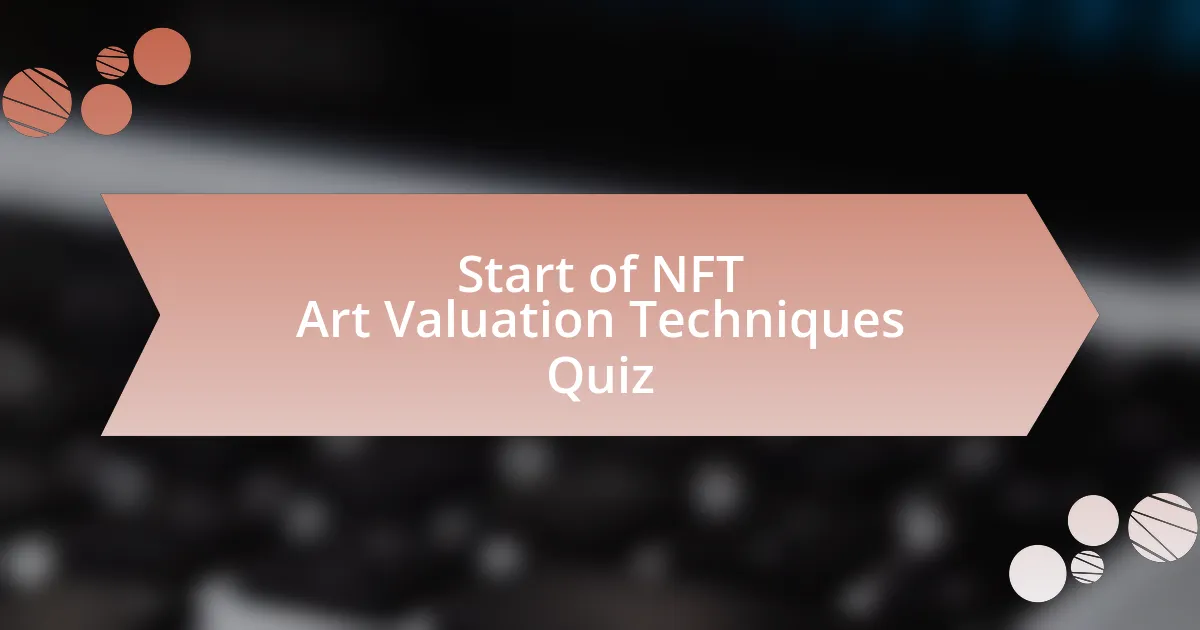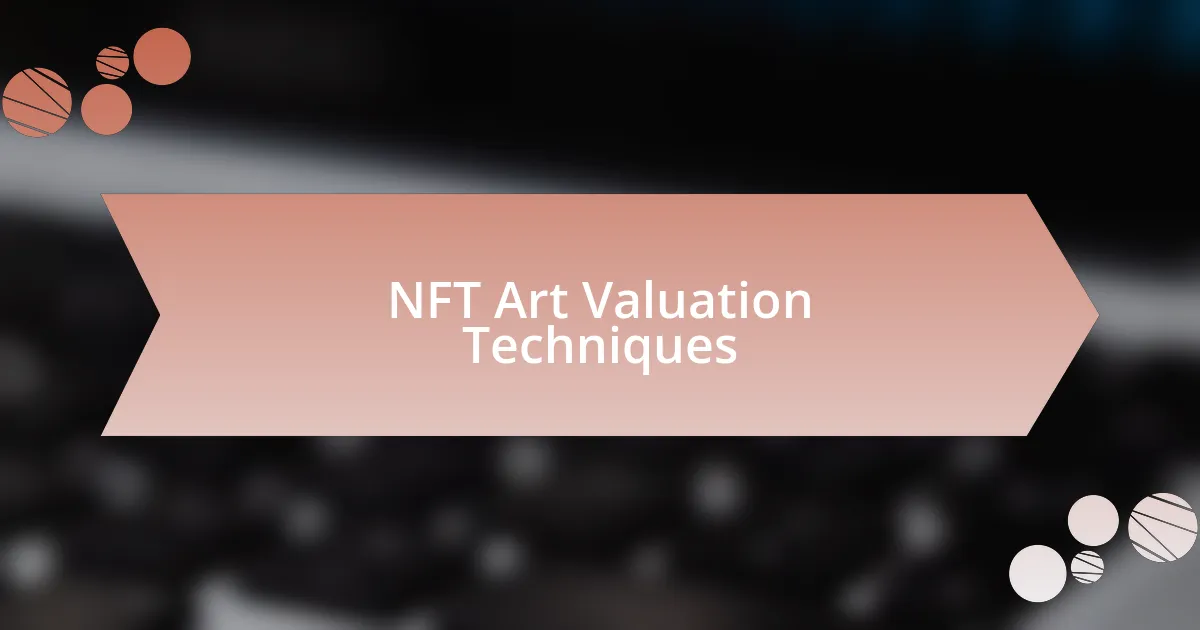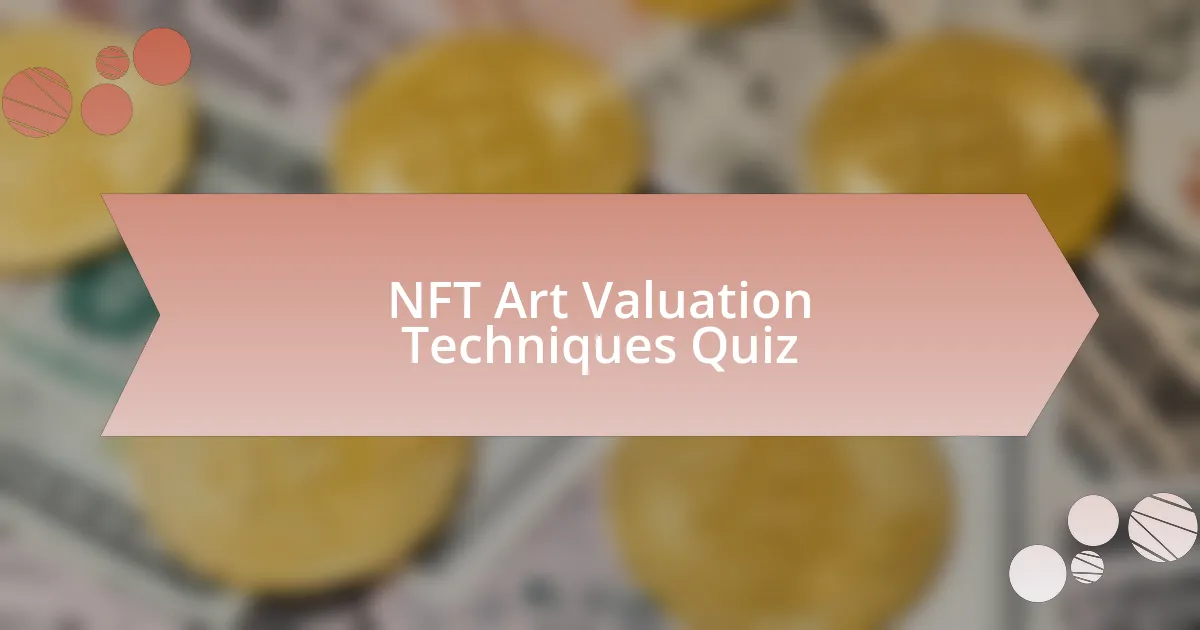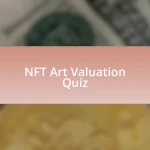
Start of NFT Art Valuation Techniques Quiz
1. What is the primary method for valuing most NFTs?
- The cost approach.
- The tax evaluation.
- The earning method.
- The market approach.
2. Why is the cost approach rarely applicable to NFTs?
- Because NFTs have no associated costs whatsoever.
- Because NFTs have a fixed cost structure that is easy to measure.
- Because NFTs are often sold at many times the cost to create them.
- Because the creation cost of NFTs is always very high.
3. What type of data is needed for the income approach to NFT valuation?
- Market trends for general NFT categories.
- Financial metrics such as revenue generated by the NFT.
- Opinions from NFT community influencers.
- Historical auction prices of similar NFTs.
4. How do NFTs generate income?
- Through renting, royalty fees, staking, liquidity pools, and farming yields.
- Through traditional auctions held in art galleries.
- By offering discounted prices to bulk buyers.
- By selling them at a fixed price to collectors.
5. What are some challenges in implementing the market approach for NFT valuation?
- Uniform pricing structures, excessive regulation, and guarantee of profit for sellers.
- Limited data sets, difficulty in comparing unique NFTs, and the need for machine learning or sampling theory.
- High transaction fees, slow processing times, and lack of popularity among collectors.
- Increased availability of digital art, ease of access to funds, and strong market demand.
6. What is the purpose of determining the similarity matrix in NFT valuation?
- To assess the popularity of NFT creators in the market.
- To understand which other NFTs resemble the token to be valued.
- To determine the selling price of all NFTs in a collection.
- To analyze the blockchain transaction history of NFTs.
7. How does the DCF method consider risk in NFT valuation?
- By considering the historical ownership and past sale values of similar NFTs.
- By assessing the total cost of creating the NFT and its sale price.
- By analyzing the number of users on the metaverse platform and the rarity of attributes within an artwork NFT.
- By estimating the public interest based solely on social media trends.
8. What are some subjective factors that must be avoided in DCF projections?
- Overly optimistic projections.
- Accurate historical data.
- Conservative estimates based on market trends.
- Comprehensive expense analysis.
9. How do NFTs provide a unique way of valuing digital art?
- By making digital art impossible to replicate.
- By providing a digital certificate of ownership and authenticity through blockchain technology.
- By increasing the physical size of the artwork.
- By allowing buyers to vote on the price of the art.
10. What are the benefits of using NFTs for art appraisals?
- Higher costs and fees associated with NFT transactions.
- Reduced visibility and exposure of digital artworks in the market.
- Faster and easier transactions, secure payments, and more flexibility and control over the artwork.
- Increased dependence on physical galleries and traditional appraisers.
11. How do NFTs disrupt traditional art appraisal processes?
- By eliminating the need for physical galleries.
- By standardizing pricing across all artworks.
- By offering a digital alternative that results in skyrocketing prices for certain works of art.
- By restricting ownership to a single entity.
12. What are some traditional methods of value determination that cannot be applied to NFTs?
- Price-to-earnings ratio, asset-based valuation, and depreciation methods.
- Supply and demand, condition assessment, and appraiser`s opinion.
- Rate of return, liquidity analysis, and tax assessments.
- Auctions, comparables, and the cost approach.
13. How do NFTs affect the value of individual pieces in a collection?
- The value of each piece is fixed and does not change.
- The value of individual pieces only depends on their creation date.
- The value of individual pieces can increase or decrease based on the overall value of the collection.
- The value is determined solely by the artist`s popularity.
14. What is the importance of determining the authenticity of digital art?
- To increase the market price of the artwork.
- To make digital art illegal for trade.
- To eliminate the use of technology in art.
- To ensure the artwork is legitimate and from the actual artist.
15. How does the stability of code and data impact digital art valuation?
- It has no impact on the value of digital art.
- It requires technical knowledge to assess the stability of the code and data.
- It only affects the popularity of the artwork.
- It determines the physical location of the artwork.
16. How do NFTs facilitate faster and easier transactions in the art market?
- Through blockchain-based authentication technologies and secure payments.
- By restricting access to high-value artworks only.
- By requiring buyers to pay in cryptocurrency exclusively.
- By eliminating the need for physical galleries and auction houses.
17. What analytics platforms can be used to value digital art?
- Platforms like Uniswap, Zora, Rarible, and Codex Protocol.
- Platforms like eBay, Amazon, Etsy, and Shopify.
- Platforms like Twitter, Instagram, Facebook, and LinkedIn.
- Platforms like Excel, PowerPoint, Word, and Access.
18. How do blockchain-based authentication technologies like Verisart help in valuing digital art?
- By requiring artists to use traditional appraisal methods.
- By lowering the prices of all digital artworks significantly.
- By establishing a physical gallery space for digital art.
- By allowing collectors to easily track and authenticate ownership of artwork.
19. What are some metrics used to value digital art across platforms?
- Popularity ranking, number of likes, artist’s follower count.
- Average user engagement, social media shares, artwork dimensions.
- Total downloads, color palette, creation date.
- Market price, estimated value of artworks, sale history.
20. How do NFTs provide more flexibility and control over digital artwork?
- By ensuring that all digital art is permanently available for free online.
- By eliminating the need for any legal contracts related to the artwork.
- By giving artists the ability to create unlimited copies of their work.
- By allowing artists to assign usage rights such as permitting or forbidding re-sale, replication, or distribution.
21. What is the role of machine learning in NFT valuation?
- To create digital art and sell it at a higher price.
- To analyze properties, traits, chain security, scarcity, release pace, and other factors to estimate the value of a token.
- To reduce the amount of data required for NFT transactions.
- To manage the aesthetic choices of artists in creating NFTs.
22. How do predictive accuracy and benchmarking work in NFT valuation using machine learning?
- By evaluating historical sales and creating a fixed pricing model for each NFT.
- By disregarding external factors and focusing only on NFT metadata.
- By learning from input fields and applying these learnings to the NFTs that need to be valued, then capturing predictive accuracy from the validation set.
- By generating random valuations without any data analysis.
23. What is the significance of combining time series methods with statistical techniques in NFT valuation?
- To account for the changing value of NFTs over time.
- To eliminate the need for expert appraisal in NFT evaluations.
- To predict future NFT trends based on social media activity.
- To establish fixed prices for all NFTs regardless of market conditions.
24. How do NFTs represent ownership of physical assets on a blockchain network?
- By creating digital replicas of physical items recorded on a ledger.
- By associating physical assets with NFTs using tags and trackers.
- By converting physical assets into cryptocurrencies on a blockchain.
- By linking smart contracts to traditional asset ownership documents.
25. What are some legal risks associated with NFTs?
- High transaction fees leading to loss of value.
- Lack of regulations and potential for fraudulent activities.
- Inability to use NFTs in traditional finance systems.
- Unclear ownership of physical artworks.
26. Can NFT metadata be changed?
- No, changes are only possible if the NFT is resold.
- Yes, but anyone can change the metadata at any time.
- Yes, only by the owner, and changes are reflected on the blockchain network.
- No, NFT metadata is permanent and cannot be altered.
27. What is an NFT drop?
- A type of cryptocurrency that can be traded freely on exchanges.
- A virtual marketplace for buying and selling art pieces.
- An auction event where digital tokens are distributed randomly.
- The launch of a non-fungible token with a specific date and time for minting.
28. How do NFTs affect the traditional art appraisal process?
- By stabilizing the market prices for all forms of art.
- By eliminating the need for appraisers entirely in the process.
- By making traditional artworks less significant than digital ones.
- By introducing a digital alternative that changes the traditional methods of value determination.
29. What are some notable challenges in the NFT landscape?
- Difficulty in creating digital art with no creativity involved.
- High transaction fees only on physical art sales.
- Inability to use smart contracts in art sales.
- Carbon footprint, lack of regulations, and speculative nature of the market.
30. How do NFTs provide a reliable method of verifying ownership and authenticity?
- With a unique address associated with physical art pieces.
- Through blockchain-based digital certificates of ownership.
- By using traditional art appraisal methods on digital pieces.
- By relying solely on market demand and popularity.

Quiz Completed Successfully!
Congratulations on completing the quiz on NFT Art Valuation Techniques! This journey has likely opened your eyes to the intricate methods used to assess the value of digital art in the ever-evolving NFT marketplace. Whether you learned about market demand, rarity, or the significance of provenance, each aspect is crucial for understanding how value is assigned to these unique digital assets.
As you reflected on each question, you may have gained insights into the balance between artistic merit and market trends. Understanding these valuation techniques not only enhances your appreciation for NFT art but also equips you with knowledge essential for making informed decisions in this exciting space. The world of digital art can be complex, but grasping these concepts provides a solid foundation for deeper exploration.
We invite you to continue expanding your knowledge! Check out the next section on this page, where we delve deeper into NFT Art Valuation Techniques. There, you will find more detailed information and resources that can further enhance your understanding of this fascinating subject. Stay curious and keep learning!

NFT Art Valuation Techniques
Understanding NFT Art Valuation
NFT art valuation refers to the process of assessing the worth of non-fungible tokens representing digital artworks. This valuation considers various factors, including artist reputation, uniqueness, and market demand. Unlike traditional art valuation, which often relies on physical characteristics, NFT art valuation emphasizes digital provenance and ownership history. As NFTs exist on the blockchain, their sale history, rarity, and community engagement play a crucial role in determining value.
Market Demand and Supply Factors in NFT Valuation
Market demand and supply significantly influence NFT art valuation. High demand for a specific artist or genre increases the price of their NFTs. Conversely, an oversupply of similar artworks can depress values. Collectors and investors consider current trends, social media buzz, and associated media coverage. These dynamics lead to rapid fluctuations in NFT pricing, making understanding market behavior crucial for accurate valuation.
Rarity and Provenance in NFT Art Valuation
Rarity and provenance are key components of NFT art valuation. Rarity refers to the scarcity of an NFT, often determined by the number of editions or copies created. Provenance tracks the ownership history and authenticity of an NFT, adding to its desirability. A well-documented provenance can elevate an NFT’s status, reassuring buyers about its legitimacy and potential future value.
Comparative Sales Analysis for NFT Valuation
Comparative sales analysis is a technique used in NFT art valuation that involves examining recent sales of similar NFTs. This method compares factors such as price, artist, edition, and comparable market conditions. It helps establish a baseline value by identifying trends in pricing for similar assets. By analyzing these sales, collectors and investors can make informed decisions regarding the potential value of an NFT.
Influence of Community Engagement on NFT Art Value
Community engagement plays a significant role in the valuation of NFT art. Artists with strong followings and active communities tend to have their NFTs valued higher. Engagement metrics, such as social media interactions and participation in events, highlight an artist’s popularity and the perceived value of their work. The strength of community support can significantly impact market demand and ultimately influence an NFT’s valuation.
What are NFT Art Valuation Techniques?
NFT Art Valuation Techniques are methods used to assess the value of non-fungible token (NFT) artworks. These techniques can include market analysis, comparable sales, and rarity assessment. For instance, market analysis examines past sales and current listings on NFT platforms to determine price trends. Comparable sales look at similar artworks to establish a benchmark value. Rarity assessment involves evaluating the uniqueness of the NFT in relation to its supply and demand in the marketplace.
How are NFT artworks typically valued?
NFT artworks are typically valued through various approaches like sales history analysis, artist reputation, and community engagement. Sales history analysis reviews previous transactions of the NFT to ascertain a market value. The reputation of the artist is crucial; established artists often command higher prices. Community engagement, such as how many likes, shares, or comments the artwork receives, also influences perceived value, reflecting demand and interest.
Where can NFT art valuation be conducted?
NFT art valuation can be conducted on multiple online marketplaces specializing in NFTs. Platforms such as OpenSea, Rarible, and Foundation provide tools and data for analyzing NFT prices. These platforms display transaction histories, listing prices, and trends, allowing users to conduct valuations effectively. Some third-party services also offer detailed valuation reports and analytics based on collected data.
When should NFT art valuation be performed?
NFT art valuation should be performed when preparing to buy, sell, or trade the artwork. Prior to a sale, it ensures the seller sets a competitive price. Buyers may seek valuation to avoid overpaying. Valuation is also essential when considering insurance or investment purposes, as it provides a documented value for asset management and financial planning.
Who performs NFT art valuations?
NFT art valuations can be performed by various entities, including professional appraisers, marketplace analysts, and collectors. Professional appraisers specialize in art and NFTs and utilize recognized valuation methods. Marketplace analysts track data on sales and trends, providing insights for valuation. Collectors often use their knowledge and experience in the market to estimate the value of NFTs they own or wish to acquire.


